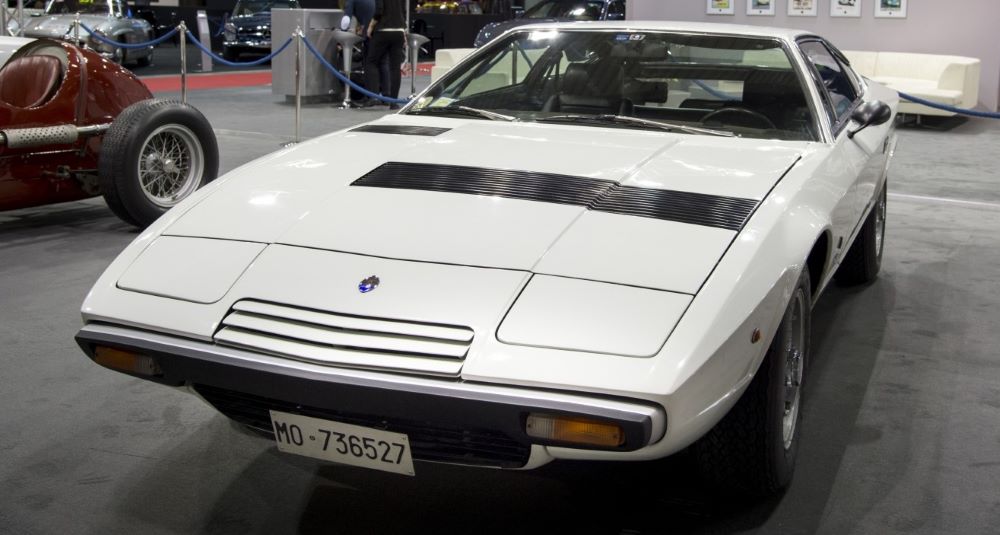
Maserati Khamsin (1972 to 1982)
Intended as a replacement for the Ghibli, Maserati’s Khamsin coupé was introduced as a prototype in autumn 1972 at the Turin motor show, only a few weeks after the launch of the Merak. At the height of the “wedge shape” design era, the Khamsin was Turin design house Bertone’s first official commission for Maserati. The production model was shown at the following Geneva motor show in March 1973. The design’s clean lines were characterized by a waistline rising gently from the pointed nose to the truncated tail, and were enhanced by innovative details such as the taillights “floating” in a rear transparent panel (unfortunately they had to be modified on the US version to comply with Federal legislation).
The wind lending its name to the new 2+2 coupé was a hot North-African desert gale blowing in Egypt and Libya. The self-supporting body rested on an unchanged 2.55 meter wheelbase, however the rear suspension was entirely new with oscillating trapeziums and differential units mounted in a sub-frame, effectively reducing both noise and vibration. The variable steering assistance was shared with the Citroën SM, as were other high-pressure hydraulics applications: brakes, clutch, pop-up headlights and driver seat adjustment. The spare wheel was fitted behind a trap door underneath the front bumper. By the time Khamsin deliveries started in 1974 both the Ghibli and Mexico had been phased out. It remained in production until 1982, with the 4.9 liter dry-sump V8 from the Ghibli SS as the sole engine choice.
German magazine Motor Revue achieved 272.2 kph (170 mph) before the unit was detuned from 320 hp to 280 hp in 1979, after which the top speed stood at 250 kph (156mph). One of the 435 cars assembled was delivered to Luciano Benetton in 1981. A subtle restyle added a small three-slot grille at the front in 1977.
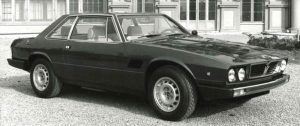
Maserati Khamsin 4.2 (1977 to 1983)
In the first year under Alejandro De Tomaso’s leadership Maserati unveiled a new model called the Kyalami which shared its basic layout and elements with the De Tomaso Longchamp coupé. Powered by Maserati’s reliable 4.2 V8, the Kyalami was seen as a transition model while the new management formulated their future plans. Even so, it proved worthy of the Trident badge.
Unveiled at the 1976 Geneva motor show, it revived a notchback four-seater coupé philosophy which had been discontinued with the last Mexico four years earlier, and fittingly took its name from the South-African race track where Pedro Rodriguez won the 1967 F1 Grand Prix driving a Cooper-Maserati T81. The Kyalami was Pietro Frua’s last creation for Maserati, crowning a successful collaboration initiated 25 years earlier.
The 4.2 liter V8 produced 265 hp (later reduced to 253 hp with a new exhaust) powering the Kyalami to a top speed of 235 kph (146 mph). The sub-frame mounted independent rear suspension descended from the Khamsin, with disc brakes installed.
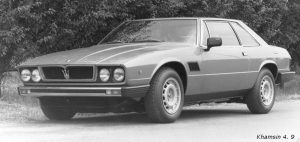
Maserati Khamsin 4. 9 (1978 to 1983)
From 1978 the 4.9 liter V8 producing 257 hp became available in the Kyalami, and consequently the car’s top speed increased to 245 kmh. A right-hand drive version of the Kyalami was added to the range that same year.
The Kyalami appealed to a clientele favoring comfort and understated elegance for long journeys. The ride was supple and the interior was plush, with Connolly leather enrobing the seats, suede covering the dashboard and thick carpets completing the picture. Out of 200 Kyalamis produced, 25 were specified with a 3-speed automatic Borg-Warner gearbox. The model remained in production until 1983 after which the Maserati range would remain without a V8 coupé until 1990 and the arrival of the Shamal.
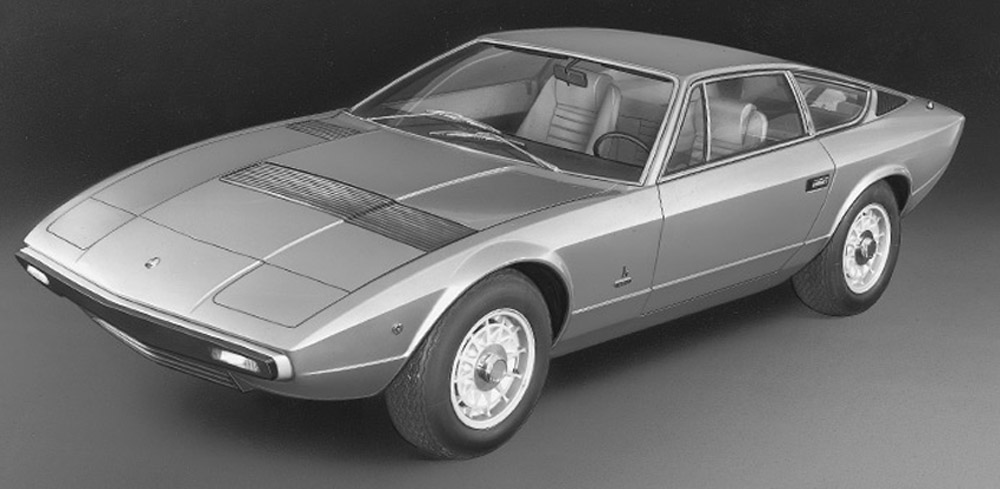
Khamsin Technical Specifications
| Model | Khamsin |
| Maserati internal code | tipo AM120 |
| Production start | 1974 |
| Number Produced | 435 |
| Ignition | single-plug, Bosch electronic ignition |
| Lubrication | dual concentric gear pumps (pressure and scavenge) |
| Transmission | 5-speed + reverse ZF (Borg Warner automatic to order) synchromesh, rear wheel drive, single dry plate clutch with hydraulic control |
| Reduction | I=2.99; II=1.90; III=1.33; IV=1; V=0.89; R=2.50 (automatic: I=2.40; II=1.47; III=1; R=2) |
| Gear ratios | 1:3.31 (automatic: 3.07) |
| Chassis | tubular / monocoque construction |
| Front suspension | double wishbones, coil springs, telescopic dampers and anti-roll bar |
| Rear suspension | double wishbones, coil springs, four telescopic dampers and anti-roll bar |
| Brakes | servo-assisted discs all round, Citroën high-pressure hydraulic system |
| Brakes front | 293.5 mm disks |
| Brakes rear | 285 mm disks |
| Steering | rack and pinion, hydraulically-assisted with servo-return |
| Cooling system | water circulation, front-mounted radiator |
| Length | 173.23 inches (4,400 mm) |
| Width | 70.86 inches (1,800 mm) |
| Height | 47.24 inches (1,200 mm) |
| Wheelbase | 100.39 inches (2,550 mm) |
| Front track | 56.6 inches (1,440 mm) |
| Rear track | 57.7 inches (1,468 mm) |
| Dry weight | 3,604 lbs (1,635 Kg) |
| Curb weight | 4,331 lbs (1,965 Kg with four passengers) |
| Tires | front/rear 215/70 VR 15 X Michelin |
| Wheels | light alloy, 7.50×15 |
| Top speed | 168 mph (270 kmh) |
| Bodywork | two-door, 2+2 coupé |
| Fuel tank | 20.90 Imperial gallons / 25 US gallons (95 liters) |
| Range | 400/500 km (320/400 miles) |
| Production dates | 1972-1982 |
| Engine | 90° V8, dry sump with separated oil tank recirculation pump |
| Bore and stroke | 93.9×89 mm |
| Total displacement | 4,930 cc |
| Displacements (unitary) | 616.33 cc |
| Compression ratio | 8.5:1 |
| Maximum power | 320 bhp at 5,500 rpm |
| Maximum torque | 49 Kgm (355.5 lbs/ft) at 4,000 rpm |
| Timing gear | two valves per cylinder, twin overhead camshafts per cylinder bank |
| Fuel feed | naturally aspirated, four vertical Weber 42 DCNF/41 double body carburetors |
| Fuel & lubricant | N 98/100 RM |
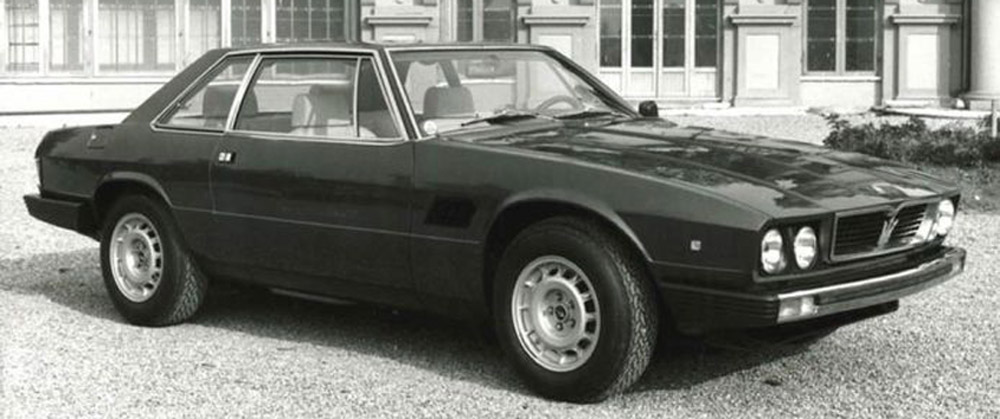
Khamsin 4.2 Technical Specifications
| Model | Kyalami 4.2 |
| Maserati internal code | Tipo AM129 |
| Production start | 1977 |
| Number Produced | 126 |
| Ignition | single-plug, electronic ignition |
| Lubrication | single oil pump, total draining |
| Transmission | 5-speed + reverse synchronized (automatic to order); rear-wheel drive; single plate dry clutch with hydraulic control, limited slip differential |
| Reduction | 1:3.54 |
| Gear ratios | I=2.99; II=1.90; III=1.32; IV=1; V=0.89; R=2.70 |
| Chassis | steel platform chassis / body integral construction |
| Front suspension | double wishbones, coil springs, telescopic dampers |
| Rear suspension | double wishbones, coil springs, telescopic dampers |
| Brakes | ventilated discs, independent, dual circuit |
| Brakes front | 288 mm disks |
| Brakes rear | 274.5 mm disks |
| Steering | power-assisted rack and pinion |
| Cooling system | front-mounted radiator |
| Length | 180 inches (4,580 mm) |
| Width | 72 inches (1,850 mm) |
| Height | 50 inches (1,270 mm) |
| Wheelbase | 102.36 inches (2,600 mm) |
| Front track | 60.2 inches (1,530 mm) |
| Rear track | 60.2 inches (1,530 mm) |
| Dry weight | 3,421 lbs (1,550 Kg) |
| Curb weight | 3,862 lbs (1,750 Kg) |
| Tires | 205/70 VR 15 XDX Michelin Tubeless |
| Wheels | light alloy casting 7.50 x 15 |
| Top speed | 150 mph (240 km/h) |
| Bodywork | two-door, 4-seater coupé, Frua design |
| Fuel tank | two tanks, total 22 Imperial gallons (100 liters) |
| 0-62 mph | 7.6 sec. |
| Production dates | 1977-1983 |
| Engine | 90° V8 |
| Bore and stroke | 88×85 mm (3.4×3.3 inches) |
| Total displacement | 4,136 cc (252.3 c.i.) |
| Displacements (unitary) | 517 cc |
| Compression ratio | 8.5:1 |
| Maximum power | 270 bhp at 6,000 rpm |
| Maximum torque | 40 Kgm (289 lbs/ft) at 3,800 rpm |
| Timing gear | two valves per cylinder, two overhead camshafts per cylinder bank |
| Fuel feed | naturally aspirated, four twin-choke Weber 42 DCNF 68 carburetors |
| Fuel & lubricant | N.O 98/100 RM |
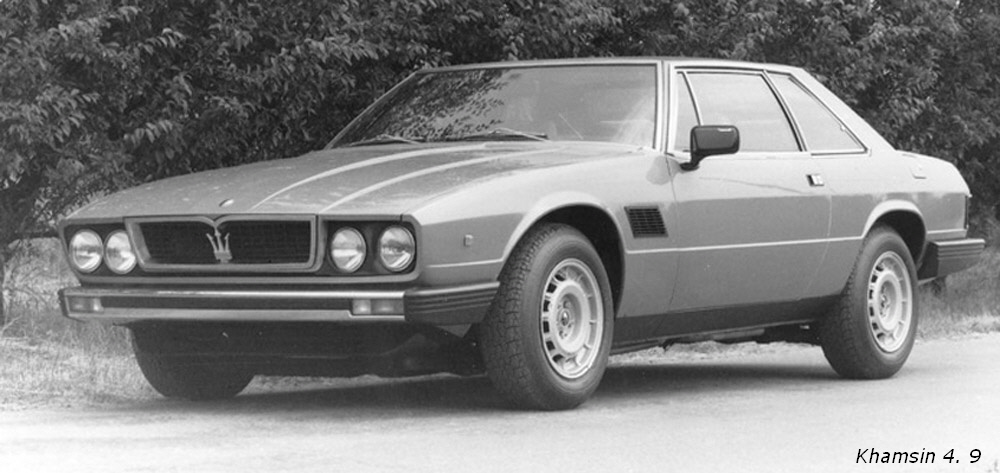
Khamsin 4.9 Technical Specifications
| Model | Kyalami 4.9 |
| Maserati internal code | Tipo AM129/49 |
| Production start | 1978 |
| Number Produced | 74 |
| Ignition | single-plug, electronic ignition |
| Lubrication | single oil pump |
| Transmission | 5-speed + reverse or automatic |
| Reduction | 1:3.54 |
| Gear ratios | I=2.99; II=1.90; III=1.32; IV=1; V=0.89; R=2.70 |
| Chassis | steel platform chassis |
| Front suspension | double wishbones, coil springs, telescopic dampers |
| Rear suspension | double wishbones, coil springs, telescopic dampers |
| Brakes | ventilated discs, independent, dual circuit |
| Brakes front | 288 mm disks |
| Brakes rear | 274.5 mm disks |
| Steering | power-assisted rack and pinion |
| Cooling system | front-mounted radiator |
| Length | 181.49 inches (4,610 mm) |
| Width | 73.62 inches (1,870 mm) |
| Height | 51.97 inches (1,320 mm) |
| Wheelbase | 102.36 inches (2,600 mm) |
| Front track | 60.2 inches (1,530 mm) |
| Rear track | 60.2 inches (1,530 mm) |
| Dry weight | 3,421 lbs (1,550 Kg) |
| Curb weight | 3,862 lbs (1,750 Kg) |
| Tires | 205/70 VR 15 XDX Michelin Tubeless |
| Wheels | light alloy casting 7.50 x 15 |
| Top speed | 150 mph (240 kmh) |
| Bodywork | two-door, 4-seater coupé, Frua design |
| Fuel tank | two tanks, total 21 Imp. gal. (100 liters) |
| Range | 400/400 km (320/400 miles) |
| 0-62 mph | 7.6 sec. |
| Production dates | 1978-1983 |
| Engine | 90° V8 |
| Bore and stroke | 93.9×89 mm |
| Total displacement | 4,930.6 cc |
| Displacements (unitary) | 616.325 cc |
| Compression ratio | 8.5:1 |
| Maximum power | 280 bhp at 5,600 rpm |
| Maximum torque | 43 Kgm (312 lbs/ft) at 3,800 rpm |
| Timing gear | two valves per cylinder, twin overhead camshafts per cylinder bank |
| Fuel feed | naturally aspirated, four Weber 42 DCNF carburetors |
| Fuel & lubricant | N.O 98/100 RM |

You must be logged in to post a comment.